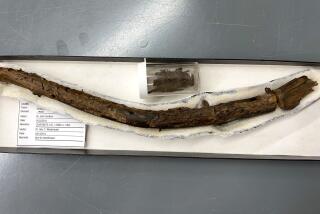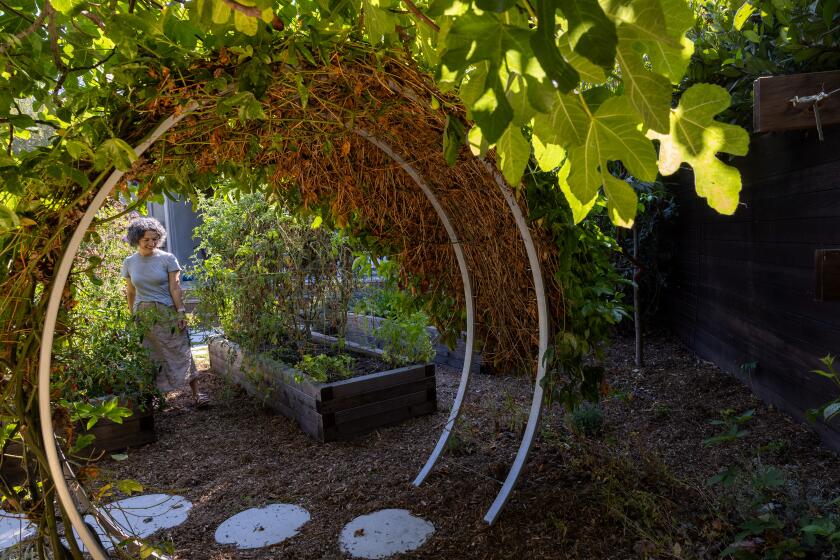GARDENING : Winter? What Winter? : Get Out the Seeds and the Tools; There’s No Downtime in O.C.
While gardeners across much of America are putting away their tools for a winter respite, gardeners in Orange County are busily planning and planting for spectacular spring blooms.
While they’re purchasing bulbs and searching through catalogues for the newest and best, local gardeners should also consider plants that will add visual interest to a winter garden.
“I like to create gardens that offer color all year long,” said Bridget Lehman Skinner, owner of Exteriors, a landscape design firm based in Costa Mesa. “Many plants produce flowers in our warm winter months because they don’t know that they aren’t supposed to.”
The choices aren’t as plentiful as in the spring or summer, but there are still plenty of options for adding color from flowers and foliage to sunny or shady locations with bedding plants, perennials, shrubs or small trees.
Camellias and azaleas are especially noteworthy for late fall and winter bloom. C. sasanquas are early bloomers. Their open flowers in hues of white, pink or red are showy through early winter, when the japonicas begin their display. Because azaleas like the same acid soil conditions, they’re frequently planted together.
There are other shrubs that produce colorful displays. Leptospermum (tea tree) is one of Skinner’s favorites, and she has several in her garden in Newport Beach.
“It performs while everyone else in the garden is sleeping,” she explained.
The varieties of leptospermum, native to Australia or New Zealand, produce clusters of small white, pink or deep red flowers, and the spiky foliage is aromatic.
Another shrub that Skinner rates highly is the lily-of-the-valley shrub ( Pieris japonica ). Although this shrub, which is related to rhododendrons and azaleas, is usually grown in the Pacific Northwest, Skinner says it can be grown successfully in Orange County as long as it receives ample water and is protected from sun and wind.
“It’s just spectacular,” she said enthusiastically. “It’s very showy even before it flowers.”
The new foliage is red or bronze-like pink before maturing to a deep, glossy green. The flower buds first appear in light green drooping clusters, before opening to blossoms of white, pink or dark red, depending on variety, beginning in February. It’s a slow-growing shrub that may take 10 years to reach a mature height of eight feet.
A faster-growing shrub that produces a spectacular flower display in late December or early January is Buddleia asiatica, a relatively new variety of the shrub popularly called butterfly bush. The fast-growing shrub can soar up to 15-feet in height in one growing season. It produces highly fragrant racemes of white flowers that smell a little like vanilla and are very attractive to butterflies and bees.
The shrub’s height can be controlled with summer pruning without sacrificing a season of bloom since it flowers on new wood. Although it’s not readily available at local nurseries, it’s worth the search. One reliable source is the Huntington Botanical Gardens in San Marino, which offers a fall plant sale Nov. 2 through 5 from 1 p.m. to 4:30 p.m.
B. asiatica is one of the many plants that will be for sale at this event, which will also include demonstrations and lectures by prominent authors of garden books. (For information, call [818] 405-2282.)
Shady sections of the garden can also be highlighted with such shade-loving plants as primulas (primrose) and cyclamen. According to Cindy Teichen, manager of Flowerdale Nursery in Costa Mesa, primula that perform reliably in Orange County are P. juliae (Juliana primrose), P. obconica , P. malacoides (Fairy primrose) and P. polyantha (English primroses).
Bergenia crassifolia is another shade plant that produces dense clusters of rose, purple or lilac flowers in January and February. Bergenia is a large-leafed perennial plant that needs ample water. The foliage remains attractive throughout the year.
Christmas rose, or Helleborus niger, also needs ample water and shade. It produces white or greenish white flowers December through April that turn purple as they age. A close relative, H. orientalis, or Lenten rose, is reputed to perform better in Orange County than H. niger, although Lenten rose blooms a little later, March through May, as the name implies.
For sunny areas, try calendula (pot marigold), pansies, violas, stock, Iceland poppies and snapdragons.
Teichen recommends planting bulbs and rhizomous plants that will bloom in spring (such as tulips, daffodils, anemones, freesias, and narcissus) and over-planting them with the bedding plants that bloom through winter. By the time their bloom cycle is over, the emerging bulbs will provide the next cycle of color.
Of the bulbous plants, crocus are often recommended for their early blooms, but Skinner’s experience has been that they aren’t reliable bloomers in our warm winter weather.
“They can bloom here, but if there’s a hot spell, the blossoms quickly wilt,” she said.
You can have a colorful winter garden by including foliage plants that offer interesting hues and textures. “Ornamental kale is a striking winter plant,” Teichen said. “Available in either purple or greenish white tones, these plants intensify their colors as the weather gets cooler.”
A bonus is that kale is edible. Remove the leaves from the outside of the clusters.
Another attractive variety is Dwarf Blue Curled, which can be used in the mixed border instead of isolating in a vegetable bed.
Paper white narcissus, a member of the daffodil family, are very reliable bloomers that will naturalize. Their fragrant, small, white blossoms emerge in December and January. They can also be grown indoors, but beware of their potent aroma, which can be overpowering.
You can also delight in fragrant, colorful flowers in December by giving sweet peas an early start. Sow them now, fertilize as the tendrils unfurl, and you’ll enjoy fragrant bouquets indoors or out by late December.
If you want to add a splash of garden color, you can use a technique Skinner recommends. She rotates containers of cymbidium orchids and places them where she wants garden color, but she is careful the delicate flowers aren’t exposed to full sun.
“They’re showy in December and January, so I like to use them when they’re in flower,” Skinner said.
When the bloom spikes are finished, she relegates the flowerless plants to an obscure place where they can grow unnoticed until they’re ready in another year to become stars of a winter garden.






